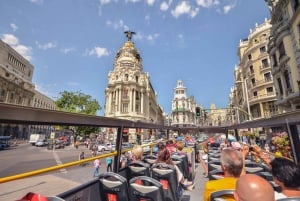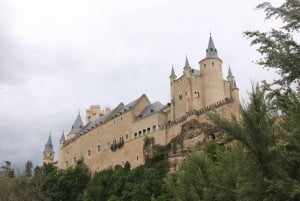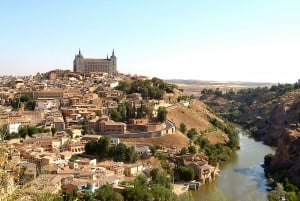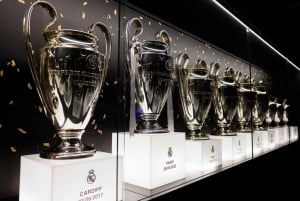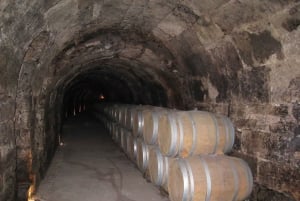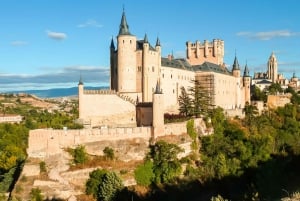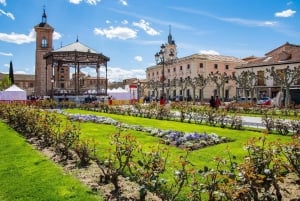Monastery
" Nobody stands in front of El Escorial without feeling glory and national pride ..., it recalls the power, wealth, civilization and the vast knowledge and influence of this great nation ... the envy of foreign nations .. " that's the way Quevedo, the famous Golden Age writer, described his feelings when seeing the great work of the Monastery.
In fact, since the end of the XVI century, due to its size, its highly symbolic value, and functional complexity in a single space, it has been regarded as the Eighth Wonder of the World.
It was built by King Philip II for two reasons: firstly, to commemorate the victory at the Battle of San Quintin near Paris, on August 10th 1557; and secondly, to meet the express wishes of his father, Emperor Carlos I, who died at Yuste, and wished to be buried in a building built ex-novo to his grave, different than their parents and grandparents. These reasons are mentioned in the founding letter of the monastery.
The Monastery was designed in the Spanish monarchic tradition in which the whole building had to serve not only as the residence of the king but also for religious purposes as a monastery and study center, basilica and library, as regulated by the Council of Trent, as well as to serve as Royal Pantheon, integrating symbolically monarchy, religion, science, and culture.
Juan Bautista Toledo was in charge of the original design and construction. We owe the original idea as a whole to him, although the final touches were given by Juan de Herrera, who adapted it to the changing needs of the Benedictines, who had doubled their initial number of monks. The façade constructed by Juan de Herrera was designed as a single unit, with only four towers to highlight its strength.
Some people see the floor plan and the four towers as an image similar to a grill, whose raison d'etre is to honor the memory of Saint Lorenzo, burned on a grill in Rome.
Basilica
The basilica is the nuclear part of the whole, around which the other units are articulated. The church is the center of the complex, reflecting religion’s importance for the Spanish monarchy.
Although the church is considered a basilica from the architectural point of view, it technically is not, as it has no real basilica floor. It was given that title from the liturgical point of view when the Pope gave it that title. The church’s floor plan is a perfect 50m2 square that reflects the idea of world harmony put forth by the Council of Trent, which requested Latin cross floors in new churches from the fifteenth century onwards.
Kindly click on the following links to know more about: Facade, Vault, Interior, Chapel, Sacristy, Chapter house and Reliquaries.
Palace
The rooms of the palace reflected the spirit of austerity and sobriety that characterized the most powerful monarch in the world at that time, the Spaniard King Felipe II. Although he had an empire, his deep religiosity dictated he live an orderly life and kept him away from any external luxury and ostentation.
Royal Pantheon
Crypt
The crypt contains 26 graves with the remains of Spanish kings and queens, from the two families that have prevailed: The Hapsburgs and the Bourbons, with the exception of Catholic King and Queen Ferdinand and Elizabeth who unified the kingdom; and their daughter Juana and her husband Philip the Handsome, buried in the Royal Chapel of Granada. Also buried away from El Escorial are Kings Felipe V and Fernando VI, who chose to be buried in the Palace at Segovia in La Granja, and the Convent of the Real Salesas respectively. The remains of King Amadeus I of Savoy and Joseph Bonaparte were buried latter at the Invalids’ in Paris.
Today all the graves are full, so the current kings of Spain would not be able to be buried there, unless they fulfill the wish of Emperor Carlos I, as stated in his will to be buried under the altar, half of his body under the altar and the other half below the priest's feet.
The Rotting room
Situated on the stairs leading to the Royal Pantheon is a forbidden place where only Augustinian monks are allowed.
This is the place where upon their death the kings’ remains were kept up to 30 years to complete the biological process of natural destruction, so their remains can fit into tiny lead trunks, that once sealed, were placed in one of the tombs in the cemetery.
Library
It is well-known that one of the missions of the Monastery was to encourage knowledge in the sciences. King Philip II donated all the manuscripts he possessed and became responsible for collecting and acquiring whole libraries and singular exemplary works, either in Spain or abroad, to build the library's holdings. It now contains about 40,000 volumes.
The library is extended over 54 meters long with 9 wide halls. The roof is a barrel vault, decorated with frescoes depicting the seven liberal arts. Juan de Herrera planned and designed the library shelves of fine woods with extraordinary carving art. Among the shelves are pictures of different Spanish monarchs, most notably that of Philip IV, painted by Velázquez.


